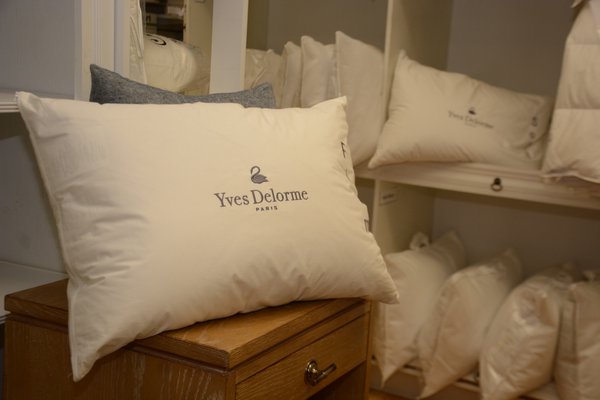

There are few rooms in a house that are used more than the bedroom and none that have maintained their character more as the place to go for privacy or intimacy or warmth.
Who hasn’t retreated to their bedrooms for all of that and the feeling that their bedroom is their private oasis? Unlike other rooms of our homes, which have either been eliminated —formal dining rooms and libraries, for example—or living rooms, which have been melded into a combined living/family/den type space, the bedroom remains as it always was, the private domain for its occupant. Naturally, the most important piece of furniture in a bedroom is the bed, in which we spend about one third of our lives. In winter we may spend even more time in our beds!
To make one’s bed comfortable and warm for the long winter’s months, I say you have to get down! Not in the dancing sense but in the sense of real “down,” as in down off a bird’s chest. It’s like making a cocoon for yourself whether you’re sleeping or wrapped up while reading or on the phone.
In the mid 1700s Thomas Nugent (an Englishman) was traveling through Germany, while taking a grand tour of Europe, when he observed with considerable surprise: “There is one thing very particular to them! They do not cover themselves with bed clothes but lay one feather bed over themselves and another one under. This is comfortable enough in winter but how they can bear their feather beds over them in summer as is generally practiced I can not conceive!” I think he may have been somewhat scandalized by the idea of people not wearing bed clothes and sleeping under the weight of heavy wool blankets as well. In any event, he clearly was unaware of thermal properties and the particular properties of a bird’s feathers and its down.
The Vikings are the first Europeans we know of who used “duvets.” Duvet is a French word meaning “down,” which is the light fluffy stuff that covers a bird’s chest. The Vikings made their duvets using eiderdown, which could be easily gathered from the nests of migrating ducks and geese. In their first incarnation, a duvet consisted of a soft flat bag filled with both feathers and down. Imagine a big pillow in a pillowcase and you have the general idea. In America we usually use the term comforter while in England they use “continental quilt” or just “quilt.” The appeal of down/feather bedding increased in the Renaissance and usage spread down from Scandinavia to the rest of Europe. As the popularity of duvets increased, innovations in the style of duvets changed. Once seen as a rural (read dirty) type of bedding, it needed to be reimagined for the middle and upper classes.
What Thomas Nugent didn’t know was that while the under duvet and over duvet looked the same, they were in fact quite different. Which brings us to the difference between feathers and down. Feathers are found on the outside of a bird; they protect the bird from the elements with an oil coating almost like a raincoat. Down is found on the underbelly and chest of the bird; it has thermal qualities that respond to the bird’s body and keep it warm. A feather also has a quill that keeps it attached to the bird while down has no quill or pointy parts. As a general rule then, feathers (since they don’t generate heat) are used in making the beds that Vikings and others slept on, while down is used in the duvets that we put over us, since they do insulate us. Down does this as a response to our individual bodies regardless of the outside temperature, as anyone who has worn a down ski jacket can attest. The northern Europeans discovered the most comfortable and sensible combination for sleeping through their vicious winters. A bed of feathers underneath which will help stop drafts coming up from the floor or ground and a duvet filled with down to generate one’s thermal heat.
Most of the improvements in both feather beds and duvet/comforters have come since the invention of the sewing machine. Sewing machines allow one to create panels or channels in which to stuff the feathers and down, it also cuts down on the down shifting to one side or to the bottom of the duvet. The best type of construction for a duvet/comforter is a baffle box, in which the down is confined to squares within the duvet usually of 12 to 15 inches. In this type of construction, the squares are not sewn through like a quilt, the baffle boxes are sewn between the top and bottom pieces of material, allowing air to circulate and increasing the insulation property of the down. Featherbeds can’t be made like that, but the best are channeled from top to bottom with dividers inside keeping the feathers within the channels. Sometimes a layer of down is sewn on top of the feather bed giving it an extra level of comfort. Picture “The Princess and the Pea” where Hans Christian Andersen tells about a princess lying on 10 eiderdown duvets (beds)!
Today the best down and feather bedding products are essentially made the same way they have always been made although there are a lot of imitation products made of man-made materials such as poly Dacron and other synthetics. For the real McCoy, one has to get off the internet and go to a store to fully appreciate the nature of down bedding, whether it be a pillow or a duvet. One of the best sources in the Hamptons is The Elegant John and Down Factory Store in Red Horse Plaza East Hampton. They have been around for more than 30 years here after many years in the city. Here you can chat with the very knowledgeable salespeople, try out the many different types of pillows, and have the various attributes of down comforters/duvets explained in full.
Some of what you’ll be told is that the best down is white goose down. Why is it the best? Because it has the highest fill power, that is it responds to the body faster and is more insulating than other downs. Usually this down is from Siberian geese for obvious reasons—Siberia is cold. You’ll also find out there’s no such thing as 100 percent down because the nature of how its gathered results in some feather parts, but usually less than 5 percent. The down is all imported to a factory in Brooklyn where it is cleaned and sanitized several times before being dried and made suitable for blowing into pillows or duvets. Another interesting fact: no one is allergic to down. Feathers, maybe, but not down. You’ll also find out that there are different weights of duvets—winter weight, mid-weight and lightweight. Something else Nugent didn’t realize was the Europeans he encountered weren’t using the same heavyweight winter duvets in the summertime; they were using lighter ones.
Down bedding lasts a long time. It’s like a collectible item. You can change duvet covers for each season to create a new look. They look gracious and in good taste on any type of bed. And if you had the extra luxury of a down-topped feather bed you might not emerge from your bedroom until spring. Take full advantage of your bedroom this winter—and “get down!”
 More Posts from Jack Crimmins
More Posts from Jack Crimmins